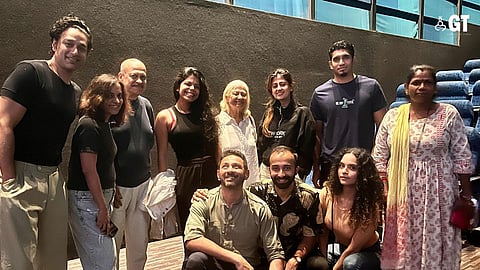Response to 90s movie surprises filmmaker based in Goa
In keeping with the trend of re-releasing films in theatres, Satya (1998), produced and directed by Ram Gopal Varma, was re-screened this weekend.
Dealing with the underworld mafia in Mumbai, Satya is Goa-based Apurva Asrani’s debut film as editor. To Apurva, the screening brought back memories of when he was barely 19, and he shared his experience at the theatre and much more.
How did it feel to watch Satya on the big screen again after all these years?
Surreal. The actors, technicians behind Satya are older today, but the characters and the craft from 1998 are still very much alive. It’s like two versions of yourself coexisting simultaneously. The power of cinema, I guess.
The actors, technicians behind Satya are older today, but the characters and the craft from 1998 are still very much alive. It’s like two versions of yourself coexisting simultaneously.
Apurva Asrani
Q. Looking back, what were the biggest challenges you faced during the making of Satya?
Satya was made when Mumbai was in the grip of the dreaded underworld. All the gangsters, shoot-outs and encounters that you see in the film were actually happening around us at that time. In fact, on one of the early days of filming, we got news that media baron Gulshan Kumar had been shot dead just a kilometre away from us. It was that real and scary. Another big challenge was that there was no script. So scenes were being improvised and shot on the go, they had to be assembled into a compelling narrative on the editing table without a clear blueprint. It was my first film as an editor, I was barely 19. But it’s down to the faith and the genius of our captain Ramgopal Varma that we pulled it off.
How do you think the film has impacted Indian cinema and the portrayal of the underworld on screen?
The response to Satya was phenomenal. The movie resonated with the frontbenchers in theatres who cheered for their underdog anti-heroes, and also the movie critics who hailed it as a gamechanger in Indian cinema. Younger filmmakers, who were inspired by the film, began to write realistic characters and stories or shot and edited their film with a newer grammar. Satya is taught in film schools and cited in research papers on film and crime even today.
One of the challenge was that there was no script. So, scenes were being improvised and shot on the go, they had to be assembled into a compelling narrative on the editing table without a clear blueprint.
Apurva Asrani
Do you think that the film is still relevant in today’s times?
To be honest, I was a bit nervous watching the film at INOX Porvorim Friday night. I feared that a younger, contemporary audience may not relate to the Mumbai of the 1990s, to the pitch of the performances, to the songs, to the length of the film (2:50 minutes), one of my longest film edits. But I was pleasantly surprised by the response. We had in the audience people in their 20s and early 30s who were hooked by the storytelling and the characters. There were Goans, migrants, senior citizens, people of all demographics who were so emotionally invested in the story that the runtime felt short. Each one commented on how powerful stories and passionate filmmaking will still find takers in cinemas.
If you were to re-edit the film, would you make changes?
I wouldn’t change a thing. Everything was in perfect sync between the cast and crew when we made the film. We practically lived, ate and drank together — living and breathing Satya. Like Ramgopal Varma said recently, ‘good films aren’t made, they just happen’. I think Satya is that rare happening that has recorded an important time in our history in an entertaining and compelling way.

